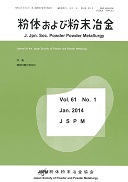All issues

Volume 61, Issue 7
July
Displaying 1-8 of 8 articles from this issue
- |<
- <
- 1
- >
- >|
Special Issue: Research Progress and New Development of Hard Materials Concerning Microstructure, Properties and Process
Summarization
-
Hideaki MATSUBARA2014Volume 61Issue 7 Pages 348-
Published: July 15, 2014
Released on J-STAGE: August 25, 2014
JOURNAL OPEN ACCESSDownload PDF (100K)
Memorial Lecture of JSPM Award
-
Hitoshi SUMIYA2014Volume 61Issue 7 Pages 349-354
Published: July 15, 2014
Released on J-STAGE: August 25, 2014
JOURNAL OPEN ACCESSABSTRACT
Novel ultra-hard materials: single-phase (binderless) polycrystalline diamond and cBN, have been produced by direct conversion sintering under static high pressure and high temperature. The polycrystalline diamond and cBN consist of fine grains of several tens or hundreds nano-meters without containing any secondary phases or binder materials. They have high hardness and high strength which surpass those of their single crystals and conventional sintered compacts containing binder materials. The fine microstructure features without any secondary phases and surpassing mechanical properties of the single-phase polycrystalline diamond and cBN are promising for applications in next-generation high-precision and high-efficiency cutting tools.View full abstractDownload PDF (1180K)
Paper
-
Hiroyuki HOSOKAWA , Kiyotaka KATO, Koji SHIMOJIMA, Ryoichi FURUSHIMA, ...2014Volume 61Issue 7 Pages 355-361
Published: July 15, 2014
Released on J-STAGE: August 25, 2014
JOURNAL OPEN ACCESSABSTRACT
The microstructures of Ti(C0.7N0.3)–19Mo2C-xNbC–24Ni cermets (x = 0, 5, 10, 15, 20) were studied. The microstructures of them consisted of hard phase with Ti(C, N) and solid soluted Ti(C, N), and Ni binder phase. The solid soluted Ti(C,N) surrounded Ti(C, N), namely, core-rim structures in the cermets with low NbC contents. The phase separation between Ti(CN) core and solid soluted Ti(C, N) occurs in the cermets with high NbC contents. As a result of TEM analysis, solid soluted Ti(C, N) nucleated surrouunding Ti(C, N) in the 5NbC, on the other hand, another site in the 20NbC. The content of Nb in solid soluted Ti(C, N) in the 20NbC was higher than that in 5NbC. The hard phase separation occurred when the lattice constant of solid soluted Ti(C, N) was beyond 4.328 Å.View full abstractDownload PDF (1386K) -
Kumiko TANAKA, Katsuhiro NISHIYAMA2014Volume 61Issue 7 Pages 362-368
Published: July 15, 2014
Released on J-STAGE: August 25, 2014
JOURNAL OPEN ACCESSABSTRACT
An experimental study for obtaining a high performance ceramics of titanium diboride and tungsten carbide composites (TBWC) are described. WC content 10 to 90 volume percent tungsten was examined. The TBWC is inexpensive and can be fabricated by a hotpress-sintering process. The TBWC with density 95 % and above of the theoretical value were obtained using constituent powder of micron size by hotpress sintering. The TBWC thus obtained consists of four phases which are (Ti, W)B2, (W, Ti)C and 2 types of (W, Ti)B. Unlike porycrystalline diamond and cBN compacts, in which the intrinsic hardness or strength of the constituents is utilized, it seems that the TBWC is basically hardened or strengthend by solution hardening or dispersion strengthening mechanisms. Those mechanisms were confirmed by metallography, X-ray diffraction, electron probe microanalysis and mechanical tests.View full abstractDownload PDF (1374K) -
Yotaro HIRABAYASHI, Shinji TAKEUCHI, Atsushi HIBINO2014Volume 61Issue 7 Pages 369-377
Published: July 15, 2014
Released on J-STAGE: August 25, 2014
JOURNAL OPEN ACCESSABSTRACT
TiAl base and Ni3Al base composite intermetallic compounds were investigated by Two-step combustion synthesis process. In TiAl–Ni3Al composite compound by the combustion synthesis, the products contain Ti2NiAl3 (τ3)and TiNi2Al (τ4) phases, and spoil the mechanical properties of the composite compound material. Therefore, Two-step combustion synthesis of TiAl base and Ni3Al base composite compounds were examined in compositions near the TiAl and Ni3Al of the Ti–Ni–Al system
Elemental (Ti+Al) premixed compact was made to react by thermal explosion reaction as first step combustion synthesis. The synthesized TiAl product was grinded, and mixed with elemental Ti, Ni and Al powders again. The (TiAl+Ti+Ni+Al) mixed compact was made to react by thermal explosion reaction as second step combustion synthesis. For the products obtained, density, phase, microstructure, Vickers hardness, and compression strength were measured.
By using Two-step combustion synthesis, TiAl base and Ni3Al base composite compounds could be fabricated. The TiAl base composite intermetallic compounds were so hard and so weak, to use for mechanical material. However Ni3Al base composite compounds contained a few Ti component exhibited superior ductility. Therefore, it was found that the addition of Ti component into Ni3Al is effective for improving the mechanical properties of Ni3Al compound.View full abstractDownload PDF (2013K)
JSPM
-
2014Volume 61Issue 7 Pages Pref7_1-
Published: July 15, 2014
Released on J-STAGE: August 25, 2014
JOURNAL OPEN ACCESSDownload PDF (1286K) -
2014Volume 61Issue 7 Pages Mtg7_2-Mtg7_6
Published: July 15, 2014
Released on J-STAGE: August 25, 2014
JOURNAL OPEN ACCESSDownload PDF (335K)
Errata
-
Satoshi NISHIDA, Masaki YOSHIDA, Hironori SUZUKI, Teruie TAKEMASU, Tak ...2014Volume 61Issue 7 Pages 381-
Published: July 15, 2014
Released on J-STAGE: August 25, 2014
JOURNAL OPEN ACCESSErrata: About the paper by Satoshi NISHIDA et al. published in Vol.61 No.6, June 2014 issue of the journal, an error in p.319 should be corrected.View full abstractDownload PDF (362K)
- |<
- <
- 1
- >
- >|